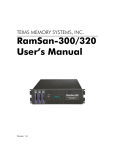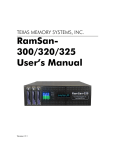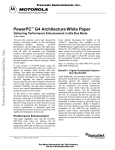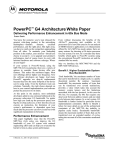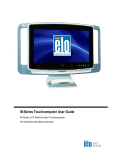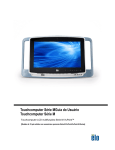Download Texas Memory Systems RAM-SAN 520 User's Manual
Transcript
RAM-SANTM User’s Guide Any trademarks or registered trademarks used in this document belong to the companies that own them. Copyright © 2003, Texas Memory Systems, Inc. All rights are reserved. No part of this work may be reproduced or used in any form or by any means - graphic, electronic or mechanical, including photocopying, recording, taping, or information storage and retrieval systems - without permission of the copyright owner. Table of Contents Chapter 1 - Overview .............................................................................................................................................................1-1 Chapter 2 - Installation ..........................................................................................................................................................2-1 2.1 Inspection .......................................................................................................................................................................2-1 2.2 E.S.D. Warning...............................................................................................................................................................2-1 2.3 Rack Mounting ...............................................................................................................................................................2-1 2.4 Connecting to the management port ...............................................................................................................................2-1 2.5 Power-Up........................................................................................................................................................................2-2 2.6 System Tests ...................................................................................................................................................................2-2 2.7 Connecting the Fibre Channel Ports ...............................................................................................................................2-2 Chapter 3 - Understanding Your RAM-SAN.......................................................................................................................3-1 3.1 Interface Slot Numbering ...............................................................................................................................................3-1 3.2 Inside the RAM-SAN .....................................................................................................................................................3-1 3.3 Bus Layout......................................................................................................................................................................3-1 3.4 Power..............................................................................................................................................................................3-1 3.5 Configuration Board and LEDs ......................................................................................................................................3-2 3.6 The Front Panel Display .................................................................................................................................................3-3 Chapter 4 – Configuring the RAM-SAN ..............................................................................................................................4-1 4.1 The RAM-SAN Monitor.................................................................................................................................................4-1 4.2 Configuring the Ethernet Port.........................................................................................................................................4-1 4.3 Configuring LUNS .........................................................................................................................................................4-1 4.3.1 A Worked Example on Changing the RAM-SAN Configuration............................................................................4-2 4.3.2 Resizing LUNs.........................................................................................................................................................4-3 4.3.3 Attaching Fibre Channel Ports to the LUNs ............................................................................................................4-3 4.3.4 Creating LUN Masks...............................................................................................................................................4-4 4.3.5 Saving the Configuration to Flash RAM .................................................................................................................4-5 Chapter 5 – Using the Management Port .............................................................................................................................5-1 5.1 testmem...........................................................................................................................................................................5-1 5.2 errchat <on/off>..............................................................................................................................................................5-1 5.3 exit (quit) ........................................................................................................................................................................5-1 5.4 help .................................................................................................................................................................................5-1 5.5 history .............................................................................................................................................................................5-2 5.6 ipconfig...........................................................................................................................................................................5-2 5.7 log ...................................................................................................................................................................................5-2 5.8 partition...........................................................................................................................................................................5-2 5.9 performance ....................................................................................................................................................................5-2 5.10 password .......................................................................................................................................................................5-2 5.11 reboot <hard/soft> ........................................................................................................................................................5-2 5.12 reset <port>...................................................................................................................................................................5-2 5.13 status [port] ...................................................................................................................................................................5-3 Chapter 6 - Troubleshooting..................................................................................................................................................6-4 6.1 Basic Items to Check ......................................................................................................................................................6-4 6.2 Management Port Fails to Boot ......................................................................................................................................6-4 6.2.1 MCP21 Does Not Display Characters .....................................................................................................................6-5 6.2.2 Boot Sequence Does Not Complete.........................................................................................................................6-5 6.2.3 Does Not Accept Character Input ............................................................................................................................6-5 6.3 RAM-SAN Boots Incorrectly .........................................................................................................................................6-5 6.3.1 RAM-SAN Detects Partial or No Memory..............................................................................................................6-5 6.3.2 RAM-SAN Does Not Detect all Devices.................................................................................................................6-6 6.3.3 Catastrophic Boot Error Detected............................................................................................................................6-6 6.4 Finding Bad Memory......................................................................................................................................................6-6 6.4.1 Locating a Bad Memory Board ...............................................................................................................................6-6 6.4.2 Confirming a Bad Memory Board ...........................................................................................................................6-6 6.5 Confidence Diagnostic, DIAGMEM, Fails ....................................................................................................................6-7 6.6 A Power Board LED Does not Light or Blinks or Bad Fuse LEDs are Lit ....................................................................6-7 6.7 Configuration LED Stays Lit..........................................................................................................................................6-7 6.8 ECC Errors Detected ......................................................................................................................................................6-8 RAM-SAN User’s Guide Texas Memory Systems, Inc. (February 7, 2003) i 6.9 How to Contact Us .........................................................................................................................................................6-8 Chapter 7 – Specifications......................................................................................................................................................7-9 7.1 Physical Characteristics ..................................................................................................................................................7-9 7.2 Operating Environment ..................................................................................................................................................7-9 7.3 Non-operating Environment ...........................................................................................................................................7-9 7.4 Warranty .........................................................................................................................................................................7-9 RAM-SAN User’s Guide Texas Memory Systems, Inc. (February 7, 2003) ii Chapter 1 - Overview The RAM-SANTM is a high-performance, multi-ported, solid-state disk. Memory capacity ranges from 16 gigabytes (GB) through 128 GB in 16 GB increments1. Memory is organized internally in 128-bit wide words and accessed via four parallel memory buses that can each sustain an aggregate bandwidth of up to 800 megabytes per second, giving a system bandwidth of up to 3.2 GB per second. The RAM-SAN features up to fifteen Fibre Channel I/O ports, each of which can sustain up to 200 megabytes per second in full duplex mode. Multiple devices can access memory simultaneously at full speed, subject to the aggregate memory bus bandwidth limit. The RAM-SAN also features a management port that is used for system diagnostics, configuration, and monitoring. The RAM-SAN 520 model also includes a hot swappable 2+1 redundant power configuration. Users should exercise caution when changing out the power supplies. 1 One gigabyte is defined as 1,073,741,824 bytes. RAM-SAN User’s Guide Texas Memory Systems, Inc. (February 7, 2003) 1-1 Chapter 2 - Installation The RAM-SAN is shipped with memory boards and interfaces already installed. Before connecting to a power supply, please perform a preliminary inspection to check for any signs of loose parts, to ensure that all interfaces are still firmly positioned in place, and to check for any obvious signs of damage. During power-up it is recommended that a terminal be attached to the management port to observe its progress through the sequence of initial power-up tests. Once the system has completed the power-up sequence, the management port should be used to execute a comprehensive system test prior to connection to external devices, as detailed in section 2.6. See Chapter 4, Configuring the RAM-SAN, for more information on other features of the management port. 2.1 Inspection Inspect the rear of the chassis. Figure 1 shows the interface slot numbers for the RAM-SAN. Make sure that all of the interfaces are securely installed in their slots, and that all screws are fully tightened. Slot 2 Slot 6 Slot 10 Slot 14 Slot 1 Slot 5 Slot 9 Slot 13 Slot 0 Slot 4 Slot 8 Slot 12 PWR-25 2A Fuse Bad 7A Fuse Bad DC ON AC ON PWR-25 2A Fuse Bad 7A Fuse Bad DC ON AC ON I O Slot 15 I Slot 11 O Slot 7 I O Slot 3 PWR-25 2A Fuse Bad 7A Fuse Bad DC ON AC ON Figure 1 – Rear view of RAM-SAN 2.2 E.S.D. Warning IMPORTANT: please take full E.S.D. precautions if it is necessary at any time to come into contact with any circuit boards, components or connectors. The components used in the RAM-SAN and its interfaces are easily damaged by electrostatic discharge. 2.3 Rack Mounting The RAM-SAN comes complete with rack slides for mounting in a standard 19” rack. 2.4 Connecting to the management port The RAM-SAN is equipped with a management port that handles system initialization during power-up. The port can also be used to execute system diagnostics, modify configuration, and monitor activity on the Fibre Channel ports. The management port supports both Ethernet and serial connections. RAM-SAN User’s Guide Texas Memory Systems, Inc. (February 7, 2003) 2-1 The management port supports Ethernet connections via Telnet. The IP address may be assigned automatically using a DHCP, BOOTP or RARP server. The IP address may also be statically set using the ‘ipconfig’ command from the serial port. The serial connection on the management port may optionally be used to communicate with the RAM-SAN. The cable provided with the RAM-SAN connects to another serial port using the following settings: 8 data bits No parity 1 stop bit 9600 baud No flow control 2.5 Power-Up The power cords are connected to the rear of the RAM-SAN chassis. The RAM-SAN is wired for 110/220 volt AC. A fully loaded RAM-SAN will draw less than 525 Watts. Turn on all 3 power modules before switching on the master power switch. This will ensure that none of the power modules are overloaded. You should see one neon bulb turn on as each module’s power switch is activated. When the master power switch is turned on, a red LED should light up on each of the three power supplies signaling OK DC power. On power-up, the system will boot up, run a few quick processor tests, and initialize all of the internal memory. If you have a serial connection to the management port, you should see the following on the display during power-up: ** ** ** ** ** Starting Creating Creating Creating Creating up TREX+ ** low-level tasks.......done monitor task..........done ethernet task.........done DEVMAN tasks..........done Texas Memory Systems, Inc. RAM-SAN monitor version x.xx At this stage the RAM-SAN is ready for use. 2.6 System Tests The management port is capable of running diagnostics on the internal memory of the RAM-SAN. This should be the first test that is run after unpacking the system. By pressing enter, a prompt should appear on the serial connection. At this point, type ‘testmem’. You may get a message that memory is still being initialized. If this happens, wait a few seconds before trying this command again. This diagnostics generates and checks data patterns in the memory system. If any error is found, a message describing the error will be displayed. See Chapter 5 for a complete description of this command. 2.7 Connecting the Fibre Channel Ports After checking the memory system, the Fibre Channel port may be connected to switches or other host bus adapters (HBAs). The ports should automatically recognize another port is connected and be ready for use. See Appendix A for a device compatibility listing. To verify a connection, use the ‘status’ command. RAM-SAN User’s Guide Texas Memory Systems, Inc. (February 7, 2003) 2-2 Chapter 3 - Understanding Your RAM-SAN 3.1 Interface Slot Numbering Each device in a RAM-SAN has a unique internal address based on the physical location of the device in the system. An interface’s port number can be determined by inspecting the back of the RAM-SAN (see Figure 1). 3.2 Inside the RAM-SAN You can open the top of the RAM-SAN by removing the screws on the lid of the system. Standing at the back of the RAMSAN and looking down into the system the interfaces are closest to you, followed by the interface motherboard, and then the memory slots. Please refer to the top-down view shown in Figure 3. As a reminder, please use caution if you open up the RAM-SAN because the system is sensitive to static discharge. Additionally, it is best to keep the RAM-SAN lid on the system while the power is on for airflow purposes. 3.3 Bus Layout The RAM-SAN achieves its high memory bandwidth by multiplexing multiple busses into system memory – four in all. A RAM-SAN bus is a direct connection to or from memory. Each bus supports up to 800MBytes per second. To maximize bus bandwidth, several devices share bus connections, and each device is individually arbitrated for bus use. Ports 0, 1, 2, and 3 are on bus A, ports 4, 5, 6, and 7 are on bus B, ports 8, 9, 10 and 11 are on bus C, and ports 12, 13, 14, and 15 are on bus D. If only a few interfaces are present in the RAM-SAN, distributing them among all four buses and putting each active DMA device alone on a bus can optimize performance. As you look at the rear of the RAM-SAN, an ideal installation of four (4) Fibre Channel ports would be to use ports 3, 7, 11 and 15. Use this same approach as the number of interface ports increase. 3.4 Power The RAM-SAN is powered by three hot-swappable power supplies that deliver a 2+1 power redundancy. The system requires that at least two of the modules be active while the system is turned on. There are LEDs on the power modules that show the status of the AC, DC and the protective fuses (see Figure 2). The AC LED should light as soon as line power is applied. The DC LED illuminates when you turn on the master power switch that is located in the lower left corner of the RAM-SAN chassis. As a reminder, do not turn on master power switch unless at least two of the power cables are connected. O I PWR-25 2A Fuse Bad 7A Fuse Bad DC ON AC ON Figure 2 – RAM-SAN Power Supply (PWR-25) The following process should be followed when hot-swapping a power supply unit: RAM-SAN User’s Guide Texas Memory Systems, Inc. (February 7, 2003) 3-1 WARNING: Please exercise caution as you hot-swap power supplies for the RAM-SAN. Failure to follow these directions could result in injury or death. If you have any questions about this procedure, call Texas Memory Systems at 713-266-3200. 1. Turn off the power module that you plan to remove. Do not remove a hot swap power module from the chassis without turning the power module off. The master power switch can remain “ON” as can the other power modules. 2. Wait 45 seconds and remove the power cord and power module. 3. Reinsert the replacement module with the new module power “OFF”. The hot swappable power supplies use a special blind mate connector to connect the RAM-SAN power motherboard. When the power board is inserted fully into the system, the power supply faceplate should be flush with the surface of the chassis. Once properly seated turn “ON” the new power module. 3.5 Configuration Board and LEDs The system configuration board is a small circuit board that holds configuration information for the various programmable components in the system. It plugs into a connector at the top of the interface motherboard (see Figure 3). The system configuration board is upgradeable to support future hardware revisions. To upgrade, simply remove the old board by pulling it towards the rear of the system and gently insert the replacement board. There are two LED packages on the interface motherboard, one on either side of the system configuration board. Most of these LEDs are dedicated to RAM-SAN diagnostics and activity monitoring, which are duplicated in detail by the front panel display (see section 3.6). The three right-most LEDs in the package on the right side of the motherboard are the system configuration LEDs. When the RAM-SAN is powered on, these three lights will turn on briefly, indicating that the programmable components in the system are being configured. If any of the lights stay on after this, the RAM-SAN has not configured correctly. If this happens, see section 6.7 in the troubleshooting section of this manual. RAM-SAN User’s Guide Texas Memory Systems, Inc. (February 7, 2003) 3-2 Figure 3 – Top-down View of RAM-SAN Internals The Front Panel Display Mounted on the front of the RAM-SAN is a front panel display (see Figure 4). When the RAM-SAN is in operation, the display reflects the system memory activity. The display monitors three things: location of memory accesses, bus bandwidth and which interface slots contain devices. RAM-SAN User’s Guide Texas Memory Systems, Inc. (February 7, 2003) 3-3 Figure 4 – RAM-SAN Front Panel The RAM-SAN display consists of four rows of lights. Each row corresponds to one of the four RAM-SAN system busses. The top row corresponds to interface ports 0, 1, 2 and 3, the next row to ports 4, 5, 6 and 7, the next row to ports 8, 9, 10 and 11, and the bottom row corresponds to interface ports 12, 13, 14, and 15. When any device on a bus is active, a light turns on in the ADDRESSES section of the display corresponding to which gigabyte of memory it is accessing. Lights in the BANDWIDTH section also turn on, showing the throughput of the bus in hundreds of megabytes per second. The right-most section of the display shows which ports are loaded with devices. If a light is on, a device is present in that slot. RAM-SAN User’s Guide Texas Memory Systems, Inc. (February 7, 2003) 3-4 RAM-SAN User’s Guide Texas Memory Systems, Inc. (February 7, 2003) 3-1 Chapter 4 – Configuring the RAM-SAN This chapter focuses on configuring the RAM-SAN. This includes configuring the Ethernet parameters, resizing LUNS, and performing LUN Masking. 4.1 The RAM-SAN Monitor The RAM-SAN is managed through an interactive command tool. The management software is accessed over Ethernet or the serial port on the RAM-SAN. See section 2.4 for more information on connecting the hardware. 4.2 Configuring the Ethernet Port The Ethernet port may be configured using automatic IP address assigned via bootp or rarp. Consult with your system administrator for the proper procedure in this type of network configuration. The following procedure may be used to statically set the IP from the serial port: 1. 2. 3. 4. Using the serial cable provided connect the management port to a serial port on a computer or dumb terminal. The serial settings should be 9600 baud, 8 data bits, no parity, and 1 stop bit. Make sure the power cable is connected to the RAM-SAN and turn it on. You should see messages on the console that show the power-on stages. Once you see the ‘ram-san>’ prompt, enter the ‘ipconfig’ command. If you are using an automated IP assignment such as reverse address resolution protocol (rarp) then select 2. Otherwise the static IP selection will prompt you for your IP, subnet mask, and gateway. Pressing return without any input will automatically pick the default value. The output from the ‘ipconfig’ command looks like this: ram-san> ipconfig 1. Static IP 2. Rarp or Bootp Select: 1 Ethernet IP address [255.255.255.255]: 192.94.231.201 Ethernet subnet mak [255.255.255.0]: <enter> Ethernet gateway [255.255.255.255]: <enter> ram-san> 5. NOTE: Type ‘reboot soft’ to reboot the RAM-SAN in order for the changes to take effect. 4.3 Configuring LUNS The RAM-SAN is extremely versatile because it supports a variety of configurations and access control methods. The factory default configuration assumes no LUN masking and equal LUN sizes for each Fibre Channel port. For example, if you have an 8 GB system with 2 Fibre Channel ports, each port will only have access to one 4 GB LUN. Any host computer attached to the same Fabric as the RAM-SAN will see two 4 GB drives. RAM-SAN 8 Gigabytes System Memory Fibre Channel ports RAM-SAN User’s Guide 4 Gigabyte drive 4 Gigabyte drive FC21 FC21 Texas Memory Systems, Inc. (February 7, 2003) 4-1 The amount of storage allocated to each Fibre Channel port may be changed using a simple configuration utility provided in the monitor. To enter this utility, type ‘partition’ on the monitor command line. You should see a message similar to this one: ram-san> ram-san> partition ** RAM-SAN partitioning utility ** Total memory size: 8192 Mb Command (h for help): To see a list of the available commands, type ‘h’ at the prompt. Command (h for help): h a add wwn to LUN Mask d delete wwn from LUN Mask l link an fc port to LUN p print the LUN table q quit without saving changes r resize LUNs u unlink an fc port from LUN w write changes to flash and exit Command (h for help): Using the ‘p’ command, you can view partition information for either a single port or the entire RAM-SAN. The following is the LUN table for the example RAM-SAN hardware configuration shown above. Command (h for help): p Enter the LUN number (1-2, default is all): <enter> LUN 1 -- 4096 Mb ports: 5 access: Open access LUN 2 -- 4096 Mb ports: 9 access: Open access Command (h for help): 4.3.1 A Worked Example on Changing the RAM-SAN Configuration The following sections detail how to change size of the LUNs within the system. We will change the factory configuration that is explained above. The new configuration will consist of three LUNs and have LUN masks that allow only four host machines to access the RAM-SAN. For the sake of discussion, we will assume we have four HBAs connected to the same fabric that the RAM-SAN’s Fibre Channel ports are attached. The new configuration will consist of three LUNs that are accessed using two Fibre Channel ports in the RAM-SAN. HBA 1 and HBA 2 will each be assigned a unique LUN, while HBA 3 and HBA 4 will share the same LUN. The goal of the example is to create the following configuration: RAM-SAN User’s Guide Texas Memory Systems, Inc. (February 7, 2003) 4-2 RAM-SAN 8 Gigabytes System Memory 3 Gigabyte drive 1 Fibre Channel ports HBA 1 3 Gigabyte drive 2 Gigabyte drive 2 FC21 HBA 2 3&4 FC21 HBA 3 HBA 4 4.3.2 Resizing LUNs The first step in changing the configuration is to resize the LUNs. Since our new configuration calls for three different LUNs, we need to use the ‘r’ command to resize LUNs. This command allows us to keep or delete the previous LUN mask and port assignments. This is useful if the only change is in the size of the LUNs. In this case, we want to delete any previous port and LUN masks that had been made. The following show the procedure for creating the three LUNs for our example. Command (h for help): r How many LUNs would you like to make? 3 Would you like to remove port assignments (Y/n)? <enter> Would you like to remove LUN masks (Y/n)? <enter> LUN 0 size (default 8192 Mb): 3072 LUN 1 size (default 5120 Mb): 3072 LUN 2 size (default 2048 Mb): <enter> Command (h for help): p Enter the LUN number (1-3, default is all): <enter> LUN 1 -- 3072 Mb ports: access: Open access LUN 2 -- 3072 Mb ports: access: Open access LUN 3 -- 2048 Mb ports: access: Open access Command (h for help): At this point, we have divided the system memory into three LUNs. Next we need to assign ports to each LUN. 4.3.3 Attaching Fibre Channel Ports to the LUNs Now that we have created our LUNs, we need to assign the Fibre Channel ports to them. This is accomplished with the ‘l’(ell) command. We simply link a particular LUN to a port number. The follow example shows how this is done. Command (h for help): l RAM-SAN User’s Guide Texas Memory Systems, Inc. (February 7, 2003) 4-3 Enter the LUN number: 1 Enter the Fibre Channel port: 5 Command (h for help): l Enter the LUN number: 2 Enter the Fibre Channel port: 5 Command (h for help): l Enter the LUN number: 3 Enter the Fibre Channel port: 9 Command (h for help): p Enter the LUN number (1-3, default is all): <enter> LUN 1 -- 3072 Mb ports: 5 access: Open access LUN 2 -- 3072 Mb ports: 5 access: Open access LUN 3 -- 2048 Mb ports: 9 access: Open access Command (h for help): From the last command, we can see that the port five has been assigned to LUN one and three, and port nine has been assigned to LUN two and three. Since we are sharing a port between two LUNs, we need to specify a LUN mask so that the HBA will only be able to access the desired LUN. 4.3.4 Creating LUN Masks The next configuration option available to the RAM-SAN is the ability to create LUN Masks for individual Fibre Channel ports. This allows the administrator to specify which HBAs are allowed to communicate with each LUN. The ‘a’ command will add a world wide name to a LUN’s access list, activating the masking of that LUN to all other HBAs. The following command sequence will add all four world wide names to our LUN mask. Command (h for help): a Enter LUN number: 1 Enter the world wide name (colon delineated): 11:11:11:11:11:11:11:11 Command (h for help): a Enter the LUN number: 2 Enter the world wide name (colon delineated): 22:22:22:22:22:22:22:22 Command (h for help): a Enter the LUN number: 3 Enter the world wide name (colon delineated): 33:33:33:33:33:33:33:33 Command (h for help): a Enter the LUN number: 3 Enter the world wide name (colon delineated): 44:44:44:44:44:44:44:44 Command (h for help): p Enter the LUN number (1-3, default is all): <enter> LUN 1 -- 3072 Mb ports: 5 access: 11:11:11:11:11:11:11:11 LUN 2 -- 3072 Mb ports: 5 access: 22:22:22:22:22:22:22:22 LUN 3 -- 2048 Mb ports: 9 access: 33:33:33:33:33:33:33:33 44:44:44:44:44:44:44:44 Command (h for help): RAM-SAN User’s Guide Texas Memory Systems, Inc. (February 7, 2003) 4-4 4.3.5 Saving the Configuration to Flash RAM The RAM-SAN has now been configured to allow access from four different HBAs to 3 different LUNs within the memory system. To actually commit the change we have made, we can use the ‘w’ command to save the configuration into Flash RAM. You may also use the ‘q’ command to quit the partitioning utility without saving any changes. RAM-SAN User’s Guide Texas Memory Systems, Inc. (February 7, 2003) 4-5 Chapter 5 – Using the Management Port The management port on the RAM-SAN allows an administrator to configure the system, monitor performance, and diagnose problems with the system. The ‘help’ command displays a list of commands available. The following sections provide a more detailed description of the commands available through the monitor. 5.1 testmem The ‘testmem’ command is used to verify the integrity of the system memory. This command causes the management port to generate and check patterns in the shared memory area. Any errors that are found are reported to the monitor along with the address in memory and the data that failed. WARNING: This test should only be run when there are no attached Fibre Channel connections because all data in system memory is overwritten by this test. The monitor also displays a line that shows the parameters associated with each test. The following is output from the ‘testmem’ command: ram-san> testmem All data in the RAM-SAN will be destroyed. Continue (yes/no)? yes Press ‘Q’ to Quit 004729 sa:0x00e8f458 wc: 0x014a5390 64-bit COMPLX RND The first number denotes the test iteration. The next two numbers are the starting address and word count for the test. The last part of the line describes the type of pattern being tested. In this case a complex 64-bit random pattern is used. This test is used to find bit error and ECC errors in system memory. Data errors will be shown as part of the ‘testmem’ command. ECC errors may be viewed using the ‘log’ command from the command line. Any ECC errors will be noted with a terminal beep and a message. NOTE: THIS COMMAND DESTROYS ALL DATA IN SYSTEM MEMORY. 5.2 errchat <on/off> The ‘errchat’ command toggles the displaying of ECC error messages. All errors are still logged to on the management port, but the error warning is not displayed. This function is useful for systems that find an error but still need to be used without the constant reporting of the error. 5.3 exit (quit) The exit command is used to close a telnet connection. This command has no effect from the console. 5.4 help The help command provides a brief online description of each command that is available. Commands that require parameters are listed with the ‘<parameters>’ as options. ram-san> help testmem errchat exit help history ipconfig log partition password performance reboot <hard/soft> reset <port> status RAM-SAN User’s Guide : : : : : : : : : : : : : Run memory diagnostics (destructive) Togles ECC error chattering on or off Logout of the monitor List a table of commands Show command line history Configure ethernet parameters Displays a list of system ecc errors Disk space allocation utility Sets the login password Displays system performance Power on reset of the RAM-SAN Resets a Fibre Channel port Prints status information Texas Memory Systems, Inc. (February 7, 2003) 5-1 5.5 history The monitor maintains a volatile command history of the last 25 commands that have been entered. Using the ‘history’ command provides a listing of the history. Commands may be entered using the ‘<’ and ‘>’ keys to scroll through this history or the unix-like ‘!’ commands. The command history is volatile and will not be maintained between power cycles. 5.6 ipconfig The ‘ipconfig’ command allows for static IP configuration of the RAM-SAN. More information on this command may be found in section 4.2. Note that setting an entry to 255.255.255.255 will cause rarp or bootp to be used. 5.7 log The ‘log’ command may be used to obtain more information on the ECC error that occurred. See section 6.4 for more information on diagnosing problems with system memory. 5.8 partition The ‘partition’ command is a memory-partitioning tool that allows the administrator to configure system memory into subsections (LUNs) that may be accessed by specific Fibre Channel ports in the RAM-SAN. The sections may also be assigned access lists (LUN masks) that limit the visibility of the RAM-SAN to specific servers. See section 4.3 for more details on partitioning the RAM-SAN. 5.9 performance The ‘performance’ command may be used to view the bandwidth of the system back plane for each port. The monitor shows the average bandwidth of each port over a period of one second. This performance view shows only DMA activity and does not show other Fibre Channel activity. To stop the output from this command, press any key. 5.10 password Since it is possible to access the RAM-SAN remotely through the management port, a password feature has been included for system security. By default, this password is not set, and thus not requested when connecting to the system. If a password is created, then all logins to the RAM-SAN will require this password. In order to change the password, the current password must be entered first. However, on the console, the password may be set without requiring the current password. The password feature may be bypassed on the console by simply pressing <enter> when prompted for the password. This feature allows a system administrator access to the RAM-SAN if the password is forgotten. 5.11 reboot <hard/soft> The reboot command has two forms. The first type is a soft reboot. The command is invoked with ‘reboot soft’. Using this command will reset the management port and disconnect from all telnet sessions. Note that this type of reboot does not destroy any data in system memory, so soft reboots are non-destructive to the RAM-SAN. The other type of reboot command is ‘reboot hard’. This command will perform a power-on reset of the system. As a result, all data stored in system memory will be destroyed. This command should only be used if all attached machines have disconnected their drives from the RAM-SAN. As an added safety precaution, this command requires the administrator to reenter the password before rebooting. 5.12 reset <port> The ‘reset’ command allows the administrator to reset individual ports on the RAM-SAN. This command should only be needed under rare circumstances since the Fibre Channel ports handle the appropriate reset protocol. To issue this command, a port number is specified as a parameter to the command. RAM-SAN User’s Guide Texas Memory Systems, Inc. (February 7, 2003) 5-2 5.13 status [port] The status command provides an overview of the RAM-SAN including Ethernet information, memory size, and the state of the Fibre Channel ports. The following output shows a sample status screen: ram-san> status Texas Memory Systems, Inc. RAM-SAN Monitor version 1.00 Ethernet address: 00:20:c2:00:07:f1 Ethernet IP: 192.94.231.201 Total memory size: 8192 MB - Ready port 1: --port 2: offline port 3: --port 4: --port 5: 10:05:00:20:c2:00:07:f1 port 6: --port 7: --port 8: --port 9: no light port 10: --port 11: --port 12: online no login port 13: --port 14: 10:05:00:20:c2:00:07:f1 port 15: --ram-san> online F-port online N-port The first few lines display the current firmware revision for the management port and the Ethernet settings associated with this RAM-SAN. The following lines show the location of the Fibre Channel ports. There are five Fibre Channels in this RAM-SAN located in ports 2, 5, 9, 12, and 14. You can also see that this is an eight-gigabyte system. Following the memory size is either the word “Initializing” or “Ready”. The box must check and initializing the system memory during power-up. Therefore, all Fibre Channel port are left offline and the word “Initializing” is displayed. Once the memory initialization is complete, the word “Ready” is displayed, and the RAM-SAN is ready for use. Each port has a line that describes the current state of the Fibre Channel port. The string ‘---‘ means that no Fibre Channel port exists in that location. The first column describes the line state of the port. A ‘no light’ string means that a signal is not being detected by the receiver. ‘Offline’ means that a signal has been detected but the low level link-up has not been made. An ‘online’ port is one that has recognized another Fibre Channel device on the other end of the connection. The second column describes the type of RAM-SAN connection port. ‘No login’ means that a link has been established but the other type of port is not yet known. An ‘F-port’ means that the RAM-SAN is connected to a fabric on that particular port, while an ‘N-port’ means a point-to-point connection with an HBA has been made. The last column is the port name (world-wide name) for the port directly connected to the RAM-SAN. The status command may also take a port number for a parameter. Entering this parameter results in a display for an individual port. All of the above information is displayed for the port along with other descriptive data such as the world wide name of the port connected to the RAM-SAN. RAM-SAN User’s Guide Texas Memory Systems, Inc. (February 7, 2003) 5-3 Chapter 6 - Troubleshooting This chapter is a quick troubleshooting guide for the most common RAM-SAN errors. To verify basic RAM-SAN operation, please consult Chapter 5 for instructions on running the system diagnostics. Below is a short list of RAM-SAN errors, symptoms and solutions. If this guide does not identify and correct your problem, please call Texas Memory Systems customer support at (713) 266-3200. 6.1 Basic Items to Check When touching any of the internal components, remember to use a grounding strap attached to the RAM-SAN chassis - the chassis is connected to earth ground from the power connector. Take care around the power modules, as they are dangerous and can hold a charge for minutes after being powered off. Do not touch the power board unless the RAM-SAN is disconnected from the power outlet and has been disconnected for more than a minute. Make sure the RAM-SAN power is off before removing or adding any memory boards or interfaces. If you are uncomfortable with any of these instructions, please feel free to call Texas Memory Systems customer support instead. See Figure 3 for a depiction of the RAM-SAN internals. The following are some general items to check if you are having problems with your system: • • • • Make sure that the RAM-SAN internal fans are blowing when your system is powered on. This proves that the RAM-SAN has power. When turning on your RAM-SAN, please be sure that the power was off for at least 30 seconds. The internal power supplies take some time to dissipate their charge. Several of the parts in the system require a full power down to properly reset. The best way to guarantee that the power supply is off is to wait until the internal RAM-SAN fans come to a complete stop. Reset your serial device. Some serial devices need to synchronize their ports with the attached device. Check that the system configuration board is properly seated in its connector at the top of the interface motherboard. If it has come loose or doesn’t look fully seated, push the board gently back into place. Make sure it is aligned in its slide rails before pushing the connectors together. 6.2 Management Port Fails to Boot When the management port fails to boot, three things can happen: • • • The MCP21 displays nothing on the dumb terminal and accepts no input from the keyboard. The MCP21 boot-up sequence does not complete and freezes somewhere in the middle of the sequence described in section 3.5. The MCP21 boots to completion but sometime afterwards the MCP21 hangs and does not accept character input. RAM-SAN User’s Guide Texas Memory Systems, Inc. (February 7, 2003) 6-4 6.2.1 MCP21 Does Not Display Characters If nothing is displayed on the dumb terminal connected to the RAM-SAN, try the following: • Check for solid serial cable connection at both the management and the debug monitor. • Be sure that the dumb terminal is set at 9600 baud, no parity, eight data bits, one stop bit, no flow control and US/CR terminator. • Try adding a null modem adapter to the serial connection. 6.2.2 Boot Sequence Does Not Complete If the RAM-SAN hangs in the middle of its boot sequence, try the following: • Verify that there is no RAM-SAN activity by viewing the bandwidth section of the front panel display (see section 3.6). If there is activity, wait for it to complete. 6.2.3 Does Not Accept Character Input If the RAM-SAN has booted successfully, but will not accept dumb terminal I/O, be sure that the ram-san> prompt is visible and you should be able to type on the console. If character I/O does not work, try the following: • • Check for solid serial cable connection at both the RAM-SAN and at the dumb terminal. Make sure that the terminal is set at 9600 baud, no parity, eight data bits, one stop bit, no flow control and US/CR terminator. 6.3 RAM-SAN Boots Incorrectly During the power-up sequence of the RAM-SAN, the management port initializes and queries the system for configuration information. During this time, minor internal diagnostics are run in the system. Most errors at this time will be one of three things: the RAM-SAN detects no or partial memory; the RAM-SAN detects no or a few of the Fibre Channel ports; the power-up sequence is interrupted by a catastrophic error such as a reset, internal trap, or SAMnet error. 6.3.1 RAM-SAN Detects Partial or No Memory If the MCP21 reports on the boot screen that partial or no memory was detected, please do the following. Always use a grounding strap and be careful around the power board – it is dangerous. Also, always turn off the power before moving any boards in the system. • • • • • • If there is an interface in slot 8, remove it or move it to another slot. If there is a blank faceplate in slot 8, remove it. Open the top lid of the RAM-SAN and then turn on the power. Verify that all power modules have both the AC and DC LEDs on and the bad fuse LEDs off. After all system activity has stopped and you see the VIM+ prompt displayed on the dumb terminal, verify that none of the configuration LEDs are lit. These are the three right-most LEDs on the interface motherboard. (See section 3.5) If any are lit, please consult section 6.7 for more information. Verify that your memory boards are in the correct memory slots. If you have two memory boards, they should be in slots 0 and 4. If you have four memory boards, they should be in slots 0,1,4 and 5. If you have six, they should be in slots 0,1,2,4,5 and 6. You must always have an even number of memory boards in the system. See Figure 3 for a depiction of the RAM-SAN memory slots. Turn off the power and verify that all memory boards are tightly seated in the memory system. To do this, press firmly on the memory board handles visible from the top of the system. The handles will distribute pressure evenly on the memory board. Turn off the power and reseat the memory boards by lifting the handles from the memory board. Be sure to wear a grounding strap attached to the RAM-SAN chassis – the RAM-SAN memory boards are one of the most expensive parts of the system. The handles are designed to use the metal card cage as a fulcrum to gently leverage out the memory boards. Once the memory board is removed, check its connector for stress or damage. Use a flashlight to check the RAM-SAN memory board connectors for damage. Seat the memory board back into the system by slowly sliding the memory board into the memory slot using the card rails as a guide. Make sure the memory board handles are up so that they hook underneath the card cage. Try to visually verify that the memory board has correctly seated into RAM-SAN User’s Guide Texas Memory Systems, Inc. (February 7, 2003) 6-5 • the memory connector – the connector has a key to keep the memory board from going in backwards or awkwardly. Once in place, use the handles to evenly leverage the memory board into the slot. If none of the above hints helped, faulty hardware may exist. Follow the steps in section 6.4, Finding Bad Memory, and try to pinpoint which memory board has a problem. Then contact Texas Memory Systems customer support at (713)266-3200. 6.3.2 RAM-SAN Does Not Detect all Devices When the boot sequence completes, all devices should be accounted for both in the READY lights on the front panel display and on the status screen printed to the dumb terminal by the management port. If any devices are missing, try the following. Please use a grounding strap and be careful around the power board – it is dangerous. • • • Verify that the system powered-up correctly by turning off the power for more than 30 seconds and then turning it back on. Verify that all power modules have both the AC and DC LEDs on and the bad fuse LEDs off. If an interface is missing from the display, reseat the interface in the RAM-SAN. First, unscrew the faceplate from the RAM-SAN. There are four screws that connect it to the chassis – one in each corner of the front plate. Always turn off the power to the RAM-SAN before removing any boards from the system. Pull the interface from the system using the handles. Examine the interface connector for stress and wear. Examine the interface and check for loose components, particularly any socketed parts. Use a flashlight to examine the interface port for stress and bent pins. Gently but firmly seat the interface into its port using the slide rails as guides and tighten the faceplate screws. 6.3.3 Catastrophic Boot Error Detected Call Texas Memory Systems for help diagnosing the problem. 6.4 Finding Bad Memory This step-by-step guide will help you locate and confirm a faulty memory board or chip in your RAM-SAN. If only a handful of bit errors are present, the problem may be with a single memory chip, which can be located using this guide. If larger sections of the data word are affected, a more general board problem may exist. See section 6 above for an example of where to look in the error message to see how many bits are at fault. Please try to pinpoint the bad board and, if possible, chip, and then contact Texas Memory Systems customer support. 6.4.1 Locating a Bad Memory Board Bad memory will be reported by the system through an ECC error message. When data is read from memory and the ECC value is incorrect, the device reports an ECC message to the management port. If the error is a single bit error, the ECC logic corrects the data bit. Multiple bit errors are not correctable by the ECC mechanism. Use the ‘log’ command to display the following screen is an example of an ECC error log report. ram-san> log Source: 0x0000, ECC word: 0x25, Burst addr: 0x0082000100, Error word cnt: 0x14 An error was detected on bit 9. Bus: 2 Board: 4 Bank: 1 6.4.2 Confirming a Bad Memory Board Once you have isolated the board and, if possible, the chip associated with an error, it is wise to double-check that the problem is truly with the memory board, and not the system slot where the board resides. To test this, turn off the power to the system, wait for the fans to stop, and swap the board in question with one of the working memory boards. (Make sure to use a grounding strap when removing boards from the system.) RAM-SAN User’s Guide Texas Memory Systems, Inc. (February 7, 2003) 6-6 Then repeat the steps above to confirm that the memory error followed the suspected board to the new board slot. Contact Texas Memory Systems with all the information you have found to begin actions to resolve the problem. 6.5 Confidence Diagnostic, DIAGMEM, Fails If the ‘testmem’ test produces error messages, use section 6.4 above to narrow down the problem to a specific memory board and, if possible, chip. If you call Texas Memory Systems customer support, be sure to log the information so the support technicians can use it to determine what part of your RAM-SAN is malfunctioning. If you trace the problem to a specific memory board, try to reseat the board by following the instructions in section 6.3.1. 6.6 A Power Board LED Does not Light or Blinks or Bad Fuse LEDs are Lit When a Hot-Swappable power supply is functioning correctly, two LEDs will be lit: AC ON and DC ON. The LEDs are on the faceplate of the power supply module (see Figure 2), and can be seen on the rear of the chassis. If the DC ON and the AC ON LEDs are off or blinking, try the following: WARNING: Please exercise caution as you hot-swap power supplies for the RAM-SAN. Failure to follow these directions could result in injury or death. If you have any questions about this procedure, call Texas Memory Systems at 713-266-3200. • • • • This is just a reminder to be sure not to touch the power board components while the power supply is plugged in and turned on. Wait for at least one minute after power-down – the power supply can hold a dangerous charge. Make sure that all RAM-SAN internal fans are operational and have unblocked airflow. The RAM-SAN power supply will go into thermal shutdown if it is not properly cooled. This will cause the power LED to blink as it turns itself on and off depending upon the internal temperature. If a bad fuse LED is lit, contact a Texas Memory Systems customer support technician for instructions on how to replace the fuse. If more than one of the power supplies have blinking lights and the fans are not running, then check the 2A Fuse Bad LED on the power supply nearest the fans. If it is also lit, then it is possible that the fans are not receiving power. Remove that power supply and contact Texas Memory Systems customer support (713-266-3200) for help replacing the fuse. Once the power supply is removed from the system, another power supply will take its place powering the fans. If the DC ON LED is not lit up, turn the power supply’s AC switch off, and leave it off for 2 minutes. A power glitch might have locked up the load sharing control and turned off the converter. The converter must discharge its internal capacitance before it will function correctly. After 2 minutes, turn the AC power switch back on and see if the DC OK LED lights up. If the LED does not light up, or this problem occurs frequently, contact Texas Memory Systems customer support to remedy the problem. Verify that the power board is properly connected to the RAM-SAN system motherboard. The hot swappable power supplies use a special blind mate connector to connect the RAM-SAN power motherboard. When the power board is inserted fully into the system, the power supply faceplate should be flush with the surface of the chassis. 6.7 Configuration LED Stays Lit Be sure all system activity is stopped before checking if the configuration LEDs are lit. The configuration LEDs share LED packages with system activity LEDs. If the system is not idle, chances are, some of the LEDs in the RAM-SAN will be lit. Configuration LEDs should only be lit upon power-up and will remain lit for only a second. Several things can cause a configuration LED to stay lit: heat, power surges, bad power, RAM-SAN User’s Guide Texas Memory Systems, Inc. (February 7, 2003) 6-7 power glitches or a serious hardware failure. If a configuration LED stays lit after power-up, do the following: • • • • Verify that the oscillator is firmly inserted into its slot. The oscillator is located in the center of the system motherboard, between the connectors for memory slot 5. The writing on the oscillator should be oriented in the same direction as the text next to it on the motherboard that reads “50MHz” and “3.3V”. Check that the system configuration board is properly seated in its connector at the top of the interface motherboard. If it has come loose or doesn’t look fully seated, push the board gently back into place. Make sure it is aligned in its slide rails before pushing the connectors together. Make sure that all RAM-SAN internal fans are operational and have unblocked airflow. The RAM-SAN power supply will go into thermal shutdown if it is not properly cooled. This will cause the power LEDs to blink as they turns themselves on and off depending upon the internal temperature. If one of the RAM-SAN power modules turns off, parts of the system will be unable to reconfigure themselves and will leave the configuration LED on. If you suspect that the RAM-SAN has experienced a power surge or glitch, turn off the RAM-SAN, wait for the internal fans to stop and then turn the system back on. 6.8 ECC Errors Detected The RAM-SAN hardware has a mechanism for detecting system data errors using an error correction code (ECC). ECC errors are caused by bits being read from system memory incorrectly and are reported to the management port. If an ECC error is detected the management port reports: ** ECC error detected Please follow the steps in section 6.4 to pinpoint the erroneous memory board and/or chip and call Texas Memory Systems customer support. You will need to be at the RAM-SAN monitor while talking to a customer support technician, with an error logged on the management port (resetting or turning off the RAM-SAN will cause the management port to lose the ECC error log). 6.9 How to Contact Us At Texas Memory Systems, Inc. we strive to meet our customers’ needs by providing quality products and documentation. This Users Guide will answer many of your initial questions. Please feel free to contact our Customer Support Department with any additional questions, concerns, or comments regarding your system. Texas Memory Systems, Inc. 11200 Westheimer Road, Suite 1000 Houston, TX 77042 www.texmemsys.com Tel: (713) 266-3200, Fax (713) 266-0332 RAM-SAN User’s Guide Texas Memory Systems, Inc. (February 7, 2003) 6-8 Chapter 7 – Specifications This chapter contains system specifications for the RAM-SAN. 7.1 Physical Characteristics Rack Mount Size: Weight: Voltage: Ventilation: 7U (12.2”) x 25” deep 90 lbs. 110/220 VAC Side to side airflow 7.2 Operating Environment 32-85 °F (0-30 °C) 80% Temperature: Max relative humidity: (non-condensing) Max heat dissipation: Power consumption: 1700 Btu/hr (500 W) 100-550 W 7.3 Non-operating Environment Temperature: Relative Humidity: (non-condensing) 32-150 °F (0-65 °C) 10-90% 7.4 Warranty 1 year FOB Texas Memory Systems, Inc. Houston, Texas RAM-SAN User’s Guide Texas Memory Systems, Inc. (February 7, 2003) 7-9 RAM-SAN User’s Guide Texas Memory Systems, Inc. (February 7, 2003) i



























